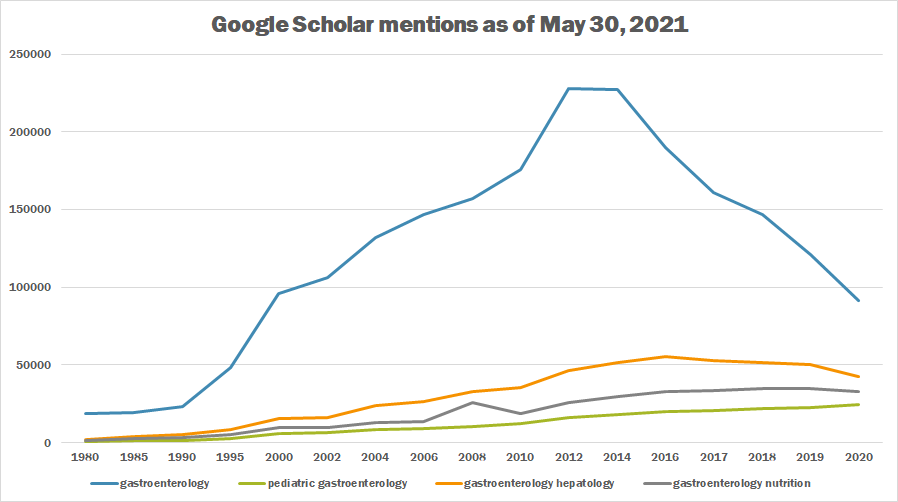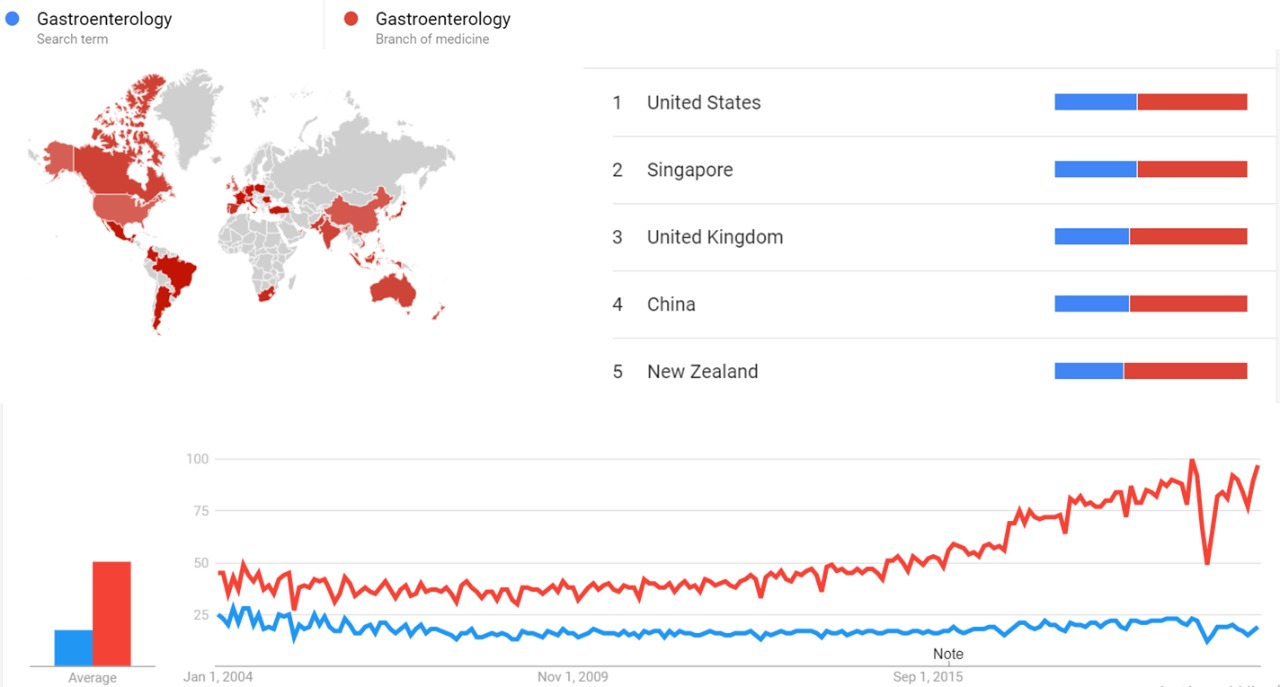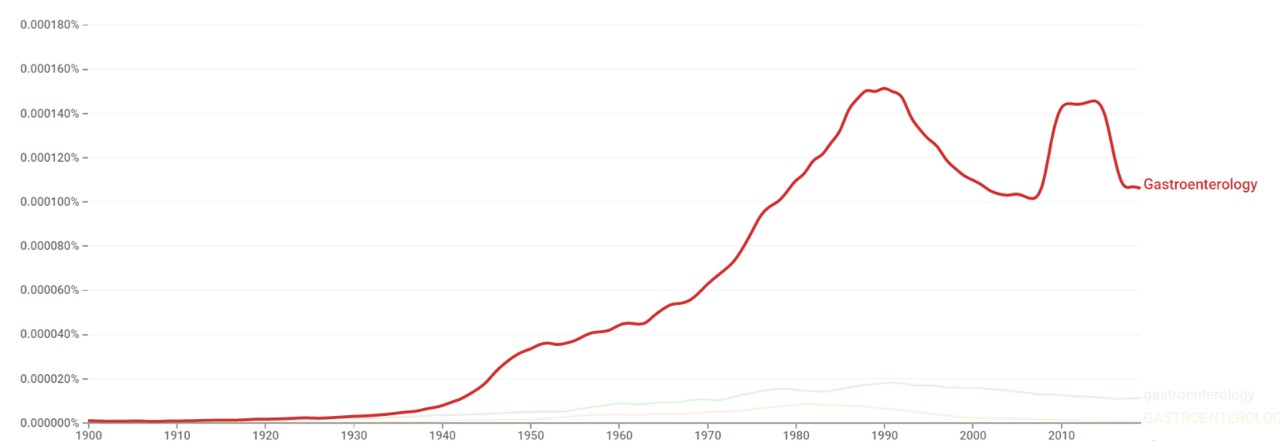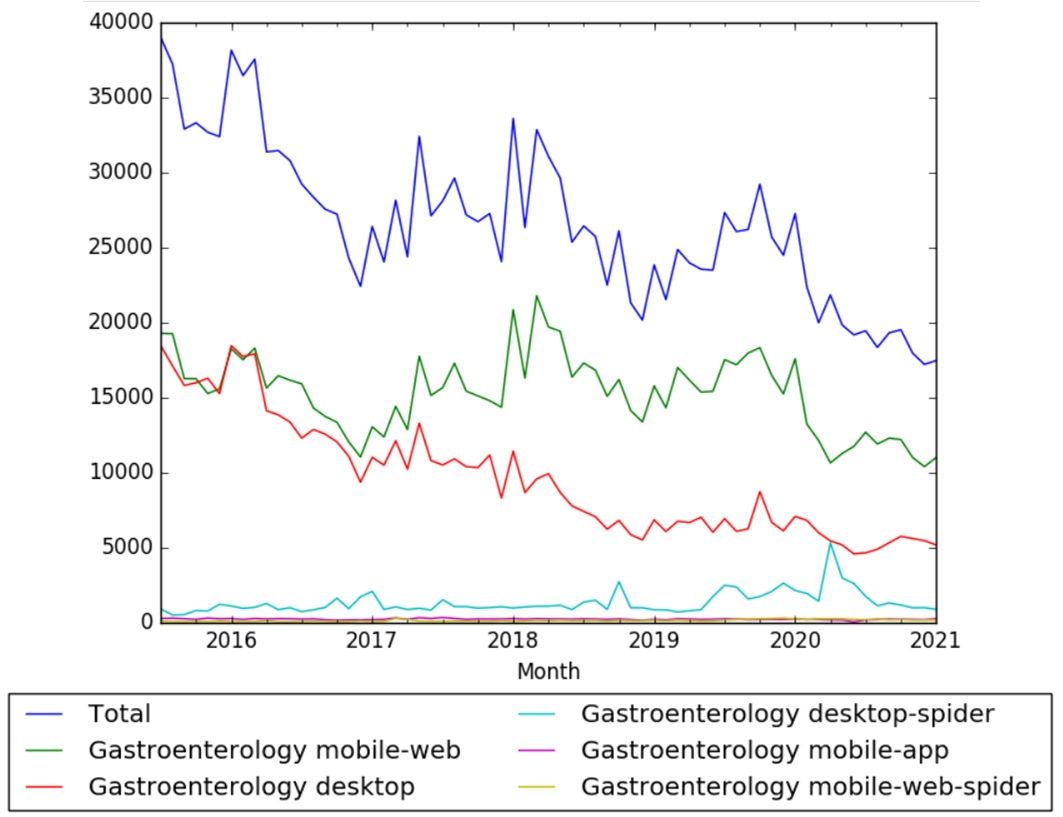Timeline of gastroenterology
This is a timeline of gastroenterology, attempting to describe significant events in the development of the field. Advances in endoscopy are largely described.
Big picture
| Time period | Development summary |
|---|---|
| 17th century | The first scientific studies of the digestive system are performed by Jan Baptist van Helmont.[1] |
| 19th century | A major advance in treatment in the 19th century is the use of gastric lavage (washing out of the stomach) to treat stomach poisoning; this becomes a standard treatment for all forms of gastric irritation, and the long tube used to introduce the lavage fluid is also adapted to view the stomach for diagnostic use.[1] The late century sees rapid advances in the understanding of the physiology and biochemistry of the digestive tract.[2] |
| 1960s | Societies of endoscopy become widely established and provided, for persons in gastroenterology training, courses in the appropriate indications for endoscopic investigation and formal teaching of the techniques involved.[3] |
| 20th century | In the 1960s and 1970s, advancements are made with endoscope lenght, improved visualization, and greater control.[4] Since the 1970s, endoscopy starts becomming the incontrovertible tool of gastroenterology.[3] |
Full timeline
| Year | Event type | Details | Location |
|---|---|---|---|
| 1767 | Scientific development | Johann Georg Ritter von Zimmermann writes an important work on dysentery.[5] | Germany |
| 1777 | Scientific development | Maximilian Stoll in Vienna describes cancer of the gallbladder.[6][7] | Austria |
| 1805 | Scientific development | German physician Philipp Bozzini makes the first attempt to observe inside the living human body by devising a tin tube illuminated by a wax candle fitted with a mirror, to examine the urinary tract, the rectum, and the pharynx. This is the earliest description of endoscopy.[8][9][10][11][12][13] | Germany |
| 1823 | Scientific development | English physician William Prout demonstrates thet the stomach contains free hydrochloric acid.[14][15][16][17] | United Kingdom |
| 1824 | Literature | William Prout publishes On the nature of acid and saline matters usually existing in the stomach of animals.[17] | United Kingdom |
| 1833 | Literature (book) | American surgeon William Beaumont publishes Experiments and Observations on the Gastric Juice and the Physiology of Digestion. Beaumont is known as the "Father of Gastric Physiology" following his research on human digestion.[18] | United States |
| 1868 | Medical development | German physician Adolf Kussmaul performs the first gastroscopy.[19][20][21] | Germany |
| 1871 | Medical development | Austrian laryngologist Karl Stoerk in Vienna demonstrates an esophagoscope made of two telescopic metal tubes.[22] | Austria |
| 1876 | Scientific development | German pathologist Karl Wilhelm Von Kupffer first describes the properties of some liver cells now called Kupffer cell.[23][24][25] | Germany |
| 1879 | Technology | American inventor Thomas Edison invents the incandescent light bulb.[26] | United States |
| 1880 | Medical development | English otorinologist Morrel Mackenzie designs a speculum type of esophagoscope.[22] | |
| 1881 | Medical development | Polish surgeon Jan Mikulicz-Radecki introduces the use of electric light to examine the esophagus.[22] | |
| 1883 | Medical development | German physiologist Karl Hugo Kroneker and Samuel James Meltzer make first use of kymograph to measure activity of the digestive tract.[27][28][29] | |
| 1886 | Medical development | Jan Mikulicz-Radecki introduces the first esophagoscope using "Mignon" small bulb.[26] | |
| 1894 | Medical development | American gynecologist Howard Atwood Kelly at Johns Hopkins Hospital in Baltimore introduces rigid sigmoidoscopy. In the same year, he writes article A New Method of Examination and Treatment of Diseases of the Rectum and Sigmoid Flexure. His instrument and technique would endure until the 1970s.[26] | United States |
| 1897 | Organization | The American Gastroenterological Association is formed.[30] | United States |
| 1911 | Medical development | H. Eisner introduces the rigid endoscope.[26] | |
| 1915 | Scientific development | American chemist Jesse Francis McClendon tests acidity of human stomach in situ.[31][32][33] | United States |
| 1940 | Medical development | The Cameron-Schindler gastroscope is introduced.[26] | |
| 1945 | Medical development | Eder semi-flexible gastroscope model 105 is introduced.[26] | |
| 1921 | Medical development | American medical doctor Walter Alvarez performs the first cutaneous electrogastrography (EEG).[34][35][36][37] | United States |
| 1932 | Medical development | German physician Rudolf Schindler and Georg Wolf develop a flexible gastroscope.[38][39][40] | United States |
| 1932 | Scientific development | American gastroenterologist Burrill Bernard Crohn describes Crohn's disease.[41][42][43] | United States |
| 1932 | Organization | The American College of Gastroenterology is founded.[44] | |
| 1932 | Medical development | German engineer Georg Wolff develops a semiflexible instrument with a flexible distal shaft, considered the first safe workable gastroscope.[4] | |
| 1934 | Literature (journal) | The American Journal of Gastroenterology is founded.[45] | United States |
| 1934 | Literature (journal) | The American Journal of Digestive Diseases and Nutrition is established.[46] | United States |
| 1937 | Organization | The British Society of Gastroenterology is founded.[2] | United Kingdom |
| 1940s | Medical development | Sclerotherapy of esophageal varices through rigid esophagoscope develops.[26] | |
| 1941 | Organization | The American Gastroscopic Club is founded.[3] | United States |
| 1943 | Literature (journal) | Medical journal Gastroenterology is established.[44] | |
| Late 1940s | Medical development | Gastric and esophageal biobsies are introduced.[26] | |
| Late 1940s | Medical development | The Eder-Chamberlain controlled tip gastroscope is introduced.[26] | |
| 1949 | Medical development | The Eder-Hufford esophagoscope is introduced.[26] | |
| 1952 | Medical development | Uji and Olympus Coroporation in Japan develop the gastrocamera.[26] | |
| 1954 | Literature (journal) | Medical journal Gastrointestinal Endoscopy is established.[47] | |
| 1954 | Medical development | H. Hopkins and N.S. Kapany describe a flexible fibroscope using glass fibers to transmit light.[26] | |
| 1957 | Medical development | Basil Hirschowitz passes a prototype instrument down his own throat, giving rise to fiber-optic endoscopy.[4] | |
| 1957 | Scientific development | Sakula and Shiner demonstrate a flat, small intestinal mucosa on biopsy of the small bowel of a chils with coeliac disease. The finding is of particular importance in the development of paediatric gastroenterology.[48] | |
| 1957 | Medical development | The fiberoptic endoscope is released.[3] | |
| 1958 | Organization | The World Gastroenterology Organisation is founded. It consists of a federation of over 100 member societies of gastroenterology, hepatology, endoscopy, and other related disciplines.[49] | |
| 1958 | Literature (journal) | Journal Diseases of the Colon & Rectum is established.[50] | |
| 1960 | Medical development | Physicians in Japan and the United States become actively engaged in developing instruments to visualize the colon.[26] | Japan, United States |
| 1961 | Medical development | American gastroenterologist Bergein Overholt conceives the idea of adapting fiberoptic technology to examination of the rectum and colon. | United States |
| 1960 | Literature (journal) | Medical journal Gut is established.[51] | |
| 1963 | Medical development | Basil Hirschowitz reports a fiberoscope evolved to include a controllable tip, forward-viewing optics, channels for insufflation, and aspiration and passage of accessories, including biopsy forceps.[26] | |
| 1963 | Medical development | Bergein Overholt develops a prototype flexible fiberoptic instrument.[4] | |
| 1965 | Medical development | The first total colonoscopy is performed in Sardinia, Italy.[4] | |
| 1966 | Literature (journal) | The Scandinavian Journal of Gastroenterology is founded.[52] | |
| 1968 | Organization | The European Society of Paediatric Gastroenterology is founded.[48] | |
| 1968 | Medical development | William S McCune and colleagues in Chicago perform the first endoscopic cannulation of the duodenal ampulla.[4] | |
| 1969 | Literature (journal) | Medical journal Endoscopy is founded.[53] | |
| 1969 | Medical development | Japanese surgeon Hiromi Shinya performs the first polypectomy, removing a 1.5cm pedunculated polyp from the sigmoid colon of a 70-year-old Chinese man.[4] | Japan |
| 1970 | Medical development | The Olympus colonoscope is released, incorporating for the first time in any fiber-optic scope a four-way tip deflection.[26] | |
| 1970 | Medical development | A "panendoscope" to allow visualization of the esophagus, stomach, and duodenum is introduced.[26] | |
| 1971 | Medical development | William I. Wolff and Hiromi Shinya begin performing colonic polyp removal with a wire snare placed through the biopsy channel of the colonoscope.[26] | |
| 1972 | Medical development | Vennes and Silvis publish their first 80 biliary cannulation attempts.[26] | |
| 1974 | Medical development | Sphincteroctomy is performed facilitating removal of two common bile duct stones and ushering a new era of therapeutic pancreaticobiliary endoscopy.[4] | |
| 1975 | Medical development | Endoscopic retrograde cholangiopancreatography (ERCP) becomes therapeutic. Endoscopic sphincteroctomy for non-surgical removal of biliary calculi.[26] | |
| 1976 | Medical development | Lutz and Rosch incorporate ultrasound into a standard endoscope when passing an ultrasound probe through an accessory port of an endoscope.[4] They report the use of 4 MHz Siemens ultrasonic probe, passed through a biopsy channel of an existing Olympus endoscope.[26] | Germany |
| 1979 | Literature (journal) | The Journal of Clinical Gastroenterology is founded.[54] | |
| 1979 | Medical development | Ponsky completes the first percutaneous endoscopic gastrostomy (PEG).[26] | |
| 1980 | Medical development | Strohm and DiMagno introduce their own prototype echoendoscopes.[4] | |
| 1980 | Medical development | Gauderer and Ponsky describe the technique of percutaneous endoscopic gastrostomy.[26] | |
| 1980 | Medical development | An ultrasonic probe with fixed-frequency transducer is incorporated into the tip of conventional fiberscope.[26] | |
| 1982 | Literature (journal) | The Indian Journal of Gastroenterology is established.[55] | India |
| 1982 | Literature (journal) | The Journal of Pediatric Gastroenterology and Nutrition is established.[56] | |
| 1983 | Medeical development | Video endoscopy is introduced.[26] | |
| 1985 | Medical development | Ultrasonic transducers with variable frequencies are incorporated into video scopes which are available by the time.[26] | |
| 1985 | Medical development | Endoscopic control of non-variceal gastrointestinal hemorrhage is introduced.[26] | |
| Mid 1980s | Medical development | The sonde enteroscope is developed.[26] | |
| 1987 | Literature (journal) | The Canadian Journal of Gastroenterology and Hepatology is launched.[57] | Canada |
| 1987 | Literature (journal) | Medical journal Alimentary Pharmacology & Therapeutics is established.[58] | |
| 1988 | Medical development | Endoscopic hemostasis clips are introduced.[26] | |
| Late 1980s | Medical development | Japanese Olympus Corporation and Fujinon become first industry leaders in videoendoscopy.[26] | Japan |
| 1989 | Literature (journal) | The European Journal of Gastroenterology & Hepatology is founded.[59] | |
| 1989 | Literature (journal) | Medical journal Neurogastroenterology & Motility is established.[60] | |
| 1990 | Medical development | Endoscopic variceal ligation is introduced.[26] | |
| Early 1990s | Medical development | The argon plasma coagulation is introduced as a medical endoscopic procedure.[26] | |
| 1991 | Medical development | Giancarlo Caletti performs on submucosal lessions of the stomach the first endoscopic ultrasound (EUS)-guided fine-needle aspiration.[4] | |
| 1991 | Medical development | Wiersema et al. demonstrate the ability to perform fine needle aspiration of nodes and lesions for the diagnosis of neoplasms of the mediastium and upper and lower gastrointestinal tract.[26] | |
| 1992 | Literature (journal) | The United European Gastroenterology is founded.[61] | |
| 1995 | Literature (journal) | Medical journal Inflammatory Bowel Diseases is first issued.[62] | |
| 1995 | Literature (journal) | The World Journal of Gastroenterology is established.[63] | |
| 2001 | Yamamoto describes "total enteroscopy with a non-surgical steerable double-balloon method".[26] | ||
| 2001 | Medical development | The United States Food and Drug Administration approves use of a capsule device for imaging of a small intestine. Images are transmitted wirelessly from a capsule to a data recorder worn by the patient.[26] | United States |
| 2001 | Medical development | Yamamoto introduces double-balloon small bowel enteroscope.[26] | |
| 2001 | Medical development | Video capsule endoscopy is introduced.[26] | |
| 2003 | Medical development | Medical journal Clinical Gastroenterology and Hepatology is first issued.[64] | |
| 2003 | Medical development | Endoscopic mucosal resection is introduced.[26] | |
| 2005 | Award | Australian scientists Barry Marshall and Robin Warren are awarded the Nobel Prize in Physiology or Medicine "for their discovery of the bacterium Helicobacter pylori and its role in gastritis and peptic ulcer disease".[65] | |
| 2005 | Medical development | Highly definition video colonoscopy is introduced.[26] | |
| 2007 | Literature (journal) | The Journal of Crohn's and Colitis is first issued.[66] | |
| 2007 | Literature (journal) | Medical journal Expert Review of Gastroenterology & Hepatology is first issued.[67] | |
| 2008 | Literature (journal) | Medical journal Clinical and Experimental Gastroenterology is first issued.[68] | |
| 2010 | Literature (journal) | Open access medical journal Clinical and Translational Gastroenterology is established.[69] | |
| 2012 | Organization | GI Forum is founded as an online community where individuals discuss and share information relevant to gastroenterology and hepatology.[70] | |
| 2012 | Medical development | Hemostatic powders are introduced for endoscopy.[26] | |
| 2013 | Medical development | FUSE omnidirectional endoscopy is introduced.[26] |
Numerical and visual data
Google Scholar
The following table summarizes per-year mentions on Google Scholar as of May 30, 2021.
| Year | gastroenterology | pediatric gastroenterology | gastroenterology hepatology | gastroenterology nutrition |
|---|---|---|---|---|
| 1980 | 18,500 | 505 | 2,340 | 1,400 |
| 1985 | 19,300 | 1,640 | 4,220 | 2,680 |
| 1990 | 23,500 | 1,750 | 5,140 | 3,290 |
| 1995 | 48,100 | 2,760 | 8,550 | 5,330 |
| 2000 | 96,100 | 6,110 | 15,800 | 9,530 |
| 2002 | 106,000 | 6,290 | 16,500 | 9,940 |
| 2004 | 132,000 | 8,400 | 23,800 | 13,000 |
| 2006 | 147,000 | 8,970 | 26,300 | 13,900 |
| 2008 | 157,000 | 10,500 | 32,800 | 25,700 |
| 2010 | 176,000 | 12,400 | 35,600 | 18,500 |
| 2012 | 228,000 | 16,300 | 46,400 | 25,600 |
| 2014 | 227,000 | 18,000 | 51,500 | 29,700 |
| 2016 | 190,000 | 20,100 | 55,700 | 33,100 |
| 2017 | 161,000 | 20,900 | 52,800 | 33,900 |
| 2018 | 147,000 | 21,900 | 51,500 | 35,200 |
| 2019 | 121,000 | 22,400 | 50,500 | 34,700 |
| 2020 | 91,300 | 24,500 | 42,300 | 33,000 |

Google Trends
The comparative chart below shows Google Trends data for Gastroenterology (Search term) and Gastroenterology (Branch of medicine), from January 2004 to February 2021, when the screenshot was taken. Interest is also ranked by country and displayed on world map.[71]

Google Ngram Viewer
The chart below shows Google Ngram Viewer data for Gastroenterology, from 1900 to 2019.[72]

Wikipedia Views
The chart below shows pageviews of the English Wikipedia article Gastroenterology, on desktop, mobile-web, desktop-spider, mobile-web-spider and mobile app, from July 2015 to January 2021.[73]

Meta information on the timeline
How the timeline was built
The initial version of the timeline was written by User:Sebastian.
Funding information for this timeline is available.
Feedback and comments
Feedback for the timeline can be provided at the following places:
- FIXME
What the timeline is still missing
Timeline update strategy
See also
External links
References
- ↑ 1.0 1.1 "Gastroenterology". britannica.com. Retrieved 1 March 2019.
- ↑ 2.0 2.1 "British Society of Gastroenterology 1937-87: an overview". europepmc.org. Retrieved 2 February 2019.
- ↑ 3.0 3.1 3.2 3.3 Hunt, Richard H. "A brief history of endoscopy". doi:10.1016/S0016-5085(01)70141-2.
{{cite journal}}: Cite journal requires|journal=(help) - ↑ 4.00 4.01 4.02 4.03 4.04 4.05 4.06 4.07 4.08 4.09 4.10 Parrillo, Joseph E.; Dellinger, R. Phillip. Critical Care Medicine: Principles of Diagnosis and Management in the Adult.
- ↑ Heirs of Hippocrates: The Development of Medicine in a Catalogue of Historic Books in the Hardin Library for the Health Sciences, the University of Iowa.
- ↑ Edgardo Rivera, MD James L. Abbruzzese, MD; Pancreatic, Hepatic, and Biliary Carcinomas, MEDICAL ONCOLOGY: A COMPREHENSIVE REVIEW [1]
- ↑ DeStoll M: Rationis Mendendi, in Nosocomio Practico vendobonensi. Part 1 LugduniBatavarum, Haak et Socios et A et J Honkoop 1788
- ↑ Gilger, MA (October 2001). "Gastroenterologic endoscopy in children: past, present, and future". Current Opinion in Pediatrics. 13 (5): 429–34. doi:10.1097/00008480-200110000-00008. PMID 11801888.
- ↑ The Origin of Endoscopes, Olympus history
- ↑ Lingeman, James E. Urinary calculi: ESWL, endourology, and medical therapy.
- ↑ Sivak, Michael V. Gastroenterologic Endoscopy: Principles and concepts of gastroenterologic endoscopy.
- ↑ Harrison, Richard M.; Wildt, David E. Animal Laparoscopy.
- ↑ "History of Gastroenterology". resident360.nejm.org. Retrieved 1 February 2019.
- ↑ Prout, W. On the nature of the acid and saline matters usually existing in the stomachs of animals. – Philos. Transactions, 1824, 1, 45.
- ↑ Modlin, Irvin M.; Sachs, George. Acid Related Diseases: Biology and Treatment.
- ↑ Rosenfeld, Louis. Four Centuries of Clinical Chemistry.
- ↑ 17.0 17.1 Yamada's Textbook of Gastroenterology (Daniel K. Podolsky, Michael Camilleri, J. Gregory Fitz, Anthony N. Kalloo, Fergus Shanahan, Timothy C. Wang ed.).
- ↑ William Beaumont Papers (1812-1959), National Library of Medicine
- ↑ Gastroenterological Endoscopy. Gastroenterological Endoscopy (Meinhard Classen, G. N. J. Tytgat, Charles J. Lightdale ed.).
- ↑ Litynski, Grzegorz S. Highlights in the history of laparoscopy: the development of laparoscopic techniques-- a cumulative effort of internists, gynecologists, and surgeons.
- ↑ Sivak, Michael V. Gastroenterologic Endoscopy: Principles and concepts of gastroenterologic endoscopy.
- ↑ 22.0 22.1 22.2 Sebastian, Anton. A Dictionary of the History of Medicine.
- ↑ Encyclopedia of Cancer (Manfred Schwab ed.).
- ↑ Pathobiology of Human Disease: A Dynamic Encyclopedia of Disease Mechanisms.
- ↑ Signaling Pathways in Liver Diseases (Jean-Francois Dufour, Pierre-Alain Clavien ed.).
- ↑ 26.00 26.01 26.02 26.03 26.04 26.05 26.06 26.07 26.08 26.09 26.10 26.11 26.12 26.13 26.14 26.15 26.16 26.17 26.18 26.19 26.20 26.21 26.22 26.23 26.24 26.25 26.26 26.27 26.28 26.29 26.30 26.31 26.32 26.33 26.34 26.35 26.36 26.37 26.38 26.39 Diagnostic and Therapeutic Procedures in Gastroenterology: An Illustrated Guide (Subbaramiah Sridhar, George Y. Wu ed.).
- ↑ Welcome, Menizibeya Osain. Gastrointestinal Physiology: Development, Principles and Mechanisms of Regulation.
- ↑ Patil, Popat N. Discoveries in Pharmacological Sciences.
- ↑ Hudson Garrison, Fielding. An Introduction to the history of medicine.
- ↑ "About AGA". gastro.org. Retrieved 2 February 2019.
- ↑ McClendon J. F. New hydrogen electrodes and rapid methods of determining hydrogen ion concentrations. – Amer. J. Physoil., 1915, 38, 2, 180.
- ↑ "Gastroenterology". gastroenterologistviswanath.com. Retrieved 3 February 2019.
- ↑ McClendon, Jesse Francis; Medes, Grace. Physical chemistry in biology and medicine.
- ↑ Alvarez W. C. The electrogastrogram and what it shows. JAMA, 78(15):1116-18, 1922.
- ↑ Galmiche, J. P. Non-ulcer Dyspepsia: Pathophysiological and Therapeutic Approaches.
- ↑ Koch, Kenneth L.; Stern, Robert Morris. Handbook of Electrogastrography.
- ↑ Encyclopedia of Biomaterials and Biomedical Engineering (Gary E. Wnek, Gary L. Bowlin ed.).
- ↑ Classen, Meinhard; Tytgat, Guido N. J. Gastroenterological Endoscopy.
- ↑ Sebastian, Anton. A Dictionary of the History of Medicine.
- ↑ Gastrointestinal Disease: An Endoscopic Approach, Volume 1 (Anthony J. DiMarino, Stanley B. Benjamin ed.).
- ↑ Ali, Tauseef. Crohn's and Colitis For Dummies.
- ↑ Dictionary of Medicine (P.H. Collin ed.).
- ↑ Newburg, Joseph. Crohn's Disease Diet and Cookbook.
- ↑ 44.0 44.1 "Seventy Years of Gastroenterology (1943–2013)". Retrieved 2 February 2019.
- ↑ Goyal, Raj K. "Seventy Years of Gastroenterology (1943–2013)". doi:10.1053/j.gastro.2013.05.020. Retrieved 2 February 2019.
{{cite journal}}: Cite journal requires|journal=(help) - ↑ "Covering Digestive Diseases and Sciences: How to Judge a Journal by Its Cover". springer.com. Retrieved 4 February 2019.
- ↑ "Capsule endoscopy: The voyage is fantastic—will it change what we do?". giejournal.org. Retrieved 2 February 2019.
- ↑ 48.0 48.1 Walker-Smith, John A. Diseases of the Small Intestine in Childhood.
- ↑ "History of WGO". worldgastroenterology.org. Retrieved 2 February 2019.
- ↑ "American Society of Colon and Rectal Surgeons announces Springer as New Publisher of Diseases of the Colon & Rectum" (PDF). Retrieved 2 February 2019.
- ↑ "British Society of Gastroenterology: golden jubilee". europepmc.org. Retrieved 2 February 2019.
- ↑ "Scandinavian Journal of Gastroenterology". tandfonline.com. Retrieved 2 February 2019.
- ↑ "Endoscopy Journal". esge.com. Retrieved 2 February 2019.
- ↑ "Journal of Clinical Gastroenterology". journals.lww.com. Retrieved 2 February 2019.
- ↑ "The Indian Journal of Gastroenterology: looking ahead at the next five years". link.springer.com. Retrieved 2 February 2019.
- ↑ "Journal of pediatric gastroenterology and nutrition [electronic resource]". library.deakin.edu.au. Retrieved 2 February 2019.
- ↑ "Canadian journal of gastroenterology & hepatology = Journal canadien de gastroenterologie et hepatologie". searchworks.stanford.edu. Retrieved 2 February 2019.
- ↑ "Alimentary Pharmacology and Therapeutics". scimagojr.com. Retrieved 2 February 2019.
- ↑ "European Journal of Gastroenterology and Hepatology". scimagojr.com. Retrieved 2 February 2019.
- ↑ "Exploring options in advanced motility training". giejournal.org. Retrieved 4 February 2019.
- ↑ "SpectraScience WavSTAT Optical Biopsy System to Be Featured at United European Gastroenterology Week". spectrascience.com. Retrieved 4 February 2019.
- ↑ "Volume 1, Issue 4, 1 November 1995". academic.oup.com. Retrieved 4 February 2019.
- ↑ "Variations of author origins in World Journal of Gastroenterology during 2001-2007". wjgnet.com. Retrieved 2 February 2019.
- ↑ Kanwal, Fasiha; El-Serag, Hashem B. "The Top Five Reasons You Should Publish in Clinical Gastroenterology and Hepatology". doi:10.1016/j.cgh.2016.11.020.
{{cite journal}}: Cite journal requires|journal=(help) - ↑ "The Nobel Prize in Physiology or Medicine for 2005". nobelprize.org. Retrieved 5 February 2019.
- ↑ "Journal of Crohn's and Colitis". academic.oup.com. Retrieved 2 February 2019.
- ↑ "Introducing Expert Review of Gastroenterology and Hepatology". doi:10.1586/17474124.1.1.1. Retrieved 4 February 2019.
{{cite journal}}: Cite journal requires|journal=(help) - ↑ "Clinical and Experimental Gastroenterology". Retrieved 2 February 2019.
{{cite journal}}: Cite journal requires|journal=(help) - ↑ "Congratulations to AJG and CTG". acgblog.org. Retrieved 2 February 2019.
- ↑ "GI Forum". facebook.com. Retrieved 5 February 2019.
- ↑ "Gastroenterology". Google Trends. Retrieved 23 February 2021.
- ↑ "Gastroenterology". books.google.com. Retrieved 23 February 2021.
- ↑ "Gastroenterology". wikipediaviews.org. Retrieved 23 February 2021.